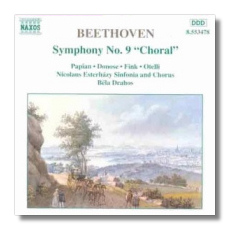
The Internet's Premier Classical Music Source
Related Links
- Beethoven Reviews
- Latest Reviews
- More Reviews
-
By Composer
-
Collections
DVD & Blu-ray
Books
Concert Reviews
Articles/Interviews
Software
Audio
Search Amazon
Recommended Links
Site News
 CD Review
CD Review
Ludwig van Beethoven

Symphony #9 "Choral" Op. 125 (1824)
Hasmik Papian, soprano
Ruxandra Donose, mezzo-soprano
Manfred Fink, tenor
Claudio Otelli, bass-baritone
Nicolaus Esterházy Sinfonia & Chorus/Béla Drahos
Naxos 8.553478 DDD 64:55
A new, well-played and recorded Beethoven Ninth is always welcome, and this is what Naxos provides. This, in spite of the fact that the catalog is bulging with dozens of versions of this "magnum opus" to choose from. Classical collectors can immediately rattle off their favorites, such as Furtwengler, Karajan, Toscanini, Szell or Walter. On period instruments, Gardiner is hard to beat, though I retain a special fondness for the performance by Roy Goodman and the Hanover Band on Nimbus (simply divine playing and singing). Although conductor Drahos and his musicians do not sweep this (considerable) field with their performance, which was recorded in Budapest in August of 1996, it is one which should find a home in many listening rooms. Those new to classical music may be attracted to it because of the low budget price, while veteran Naxos collectors who have already sampled the art of this conductor in a series of Haydn symphonies and other Beethoven works recorded by Naxos will wish to acquire it without much prompting.
What did I think? First, a few generalities. The orchestral ensemble sounds tight (that's good; much better than uptight). Conductor Drahos favors insistence and persistence in this symphony. But he finds no place for overly dramatic pauses or ritards, nor lethargy. The period instrument, historically informed tempos this work has received in the last decade are much in evidence. Drahos's musicians create atmosphere from the very opening bar, and a fresh, ripe sound peppered with concise and accented musical gestures is what emerges. The emphasis is on inevitable motion, climaxed by the attainment of the "ode to joy theme" in the finale.
Now, a few specifics. I found the first two movements to be the most successful, perhaps in part because I expect more from the third (adagio) and 4th (presto finale). In the first two, though, the performance benefits from excellent and prominent wind playing – one of the highlights of the disc. The timpanist is well recorded here as well. The third movement, which can almost send me to heaven if done correctly, lacks that extra measure of peace, bliss and spiritual, singing love. The final movement begins with much expression in the low strings. The basoonist "sings" the hymn wonderfully. If you enjoy emphatic entrances by the vocal soloist, then Claudio Otelli, who slightly overdoes it, is your man. He does settle into some nice ensemble singing later in the movement. While the women were okay, I really enjoyed tenor Manfred Fink's contribution to the finale. Here is a voice abounding with power, lyricism and intelligence! The choral parts at times were a bit harsh sounding, but appropriately joyous (if not always perfectly pitched) toward the conclusion. Drahos obtains a unique effect at the point when the male voices are joined by the stern low brass: for a second or two, you will hear a connection between this music and Gregorian chant. An articulate and forceful timpani part should help drive and crown the finale, but in this recording, the sound of that instrument is subdued in this section, only to find itself again at the very last.
A critic elslewhere (Fanfare, Volume 20, #3) previously criticized Drahos for a Beethoven Third lacking in drama and tension and sense of line, yet praised him for clear, precise rhythm in a recording of Symphony Eight, making reference to the energetic, attractive playing of the orchestra. I would say that in the Ninth, these same virtues are amply in evidence, plus Drahos never loses sight of the musical line. And, while this is not the "be all, end all" performance for reasons mentioned above, it boasts an excellent, well-separated recorded sound. Listeners interested in spending next to nothing can safely add this CD to their collection. Added recommendation: if you are a fan of the Ninth and would like a modern recording that provides elements missing from the Drahos (such as an incredible sense of occasion), then shell out a whopping three or four bucks for Laserlight 15826. What you will get in return is Herbert Blomstedt leading the Dresden Staatskapelle in a live performance of unrelenting wonder, power, spirituality and amazement. The orchestral playing (including brass and percussion in the finale) and singing are excellent, and the female soloists wonderful – surely Beethoven smiled at this event.
Copyright © 1997, Peter S. Murano


















